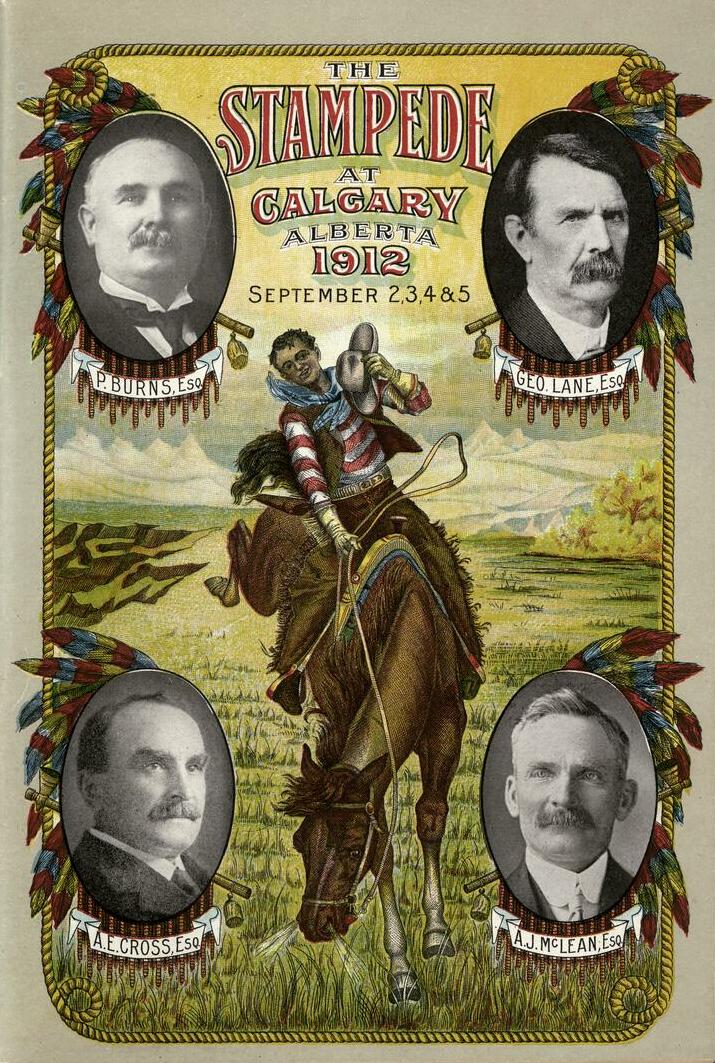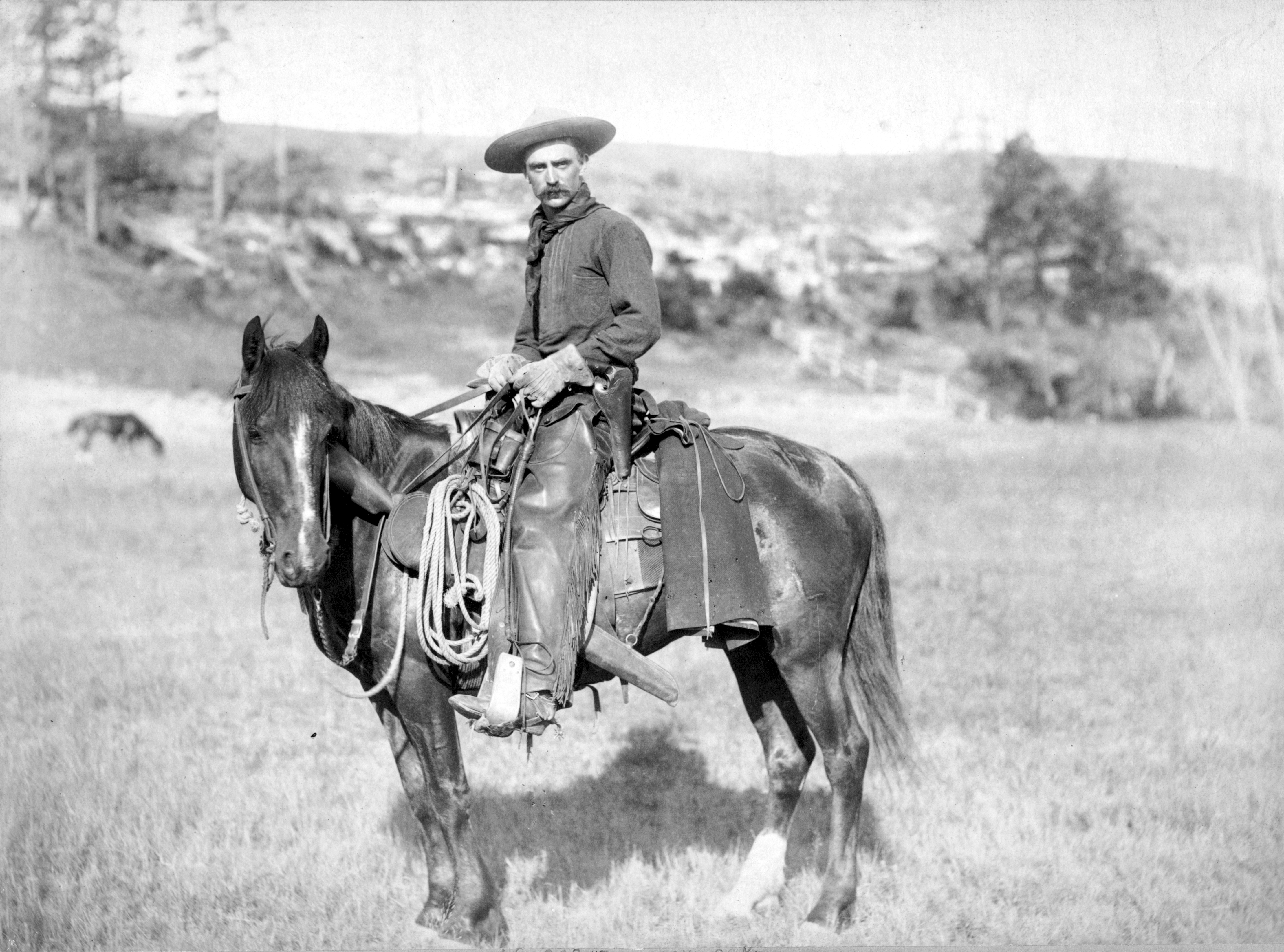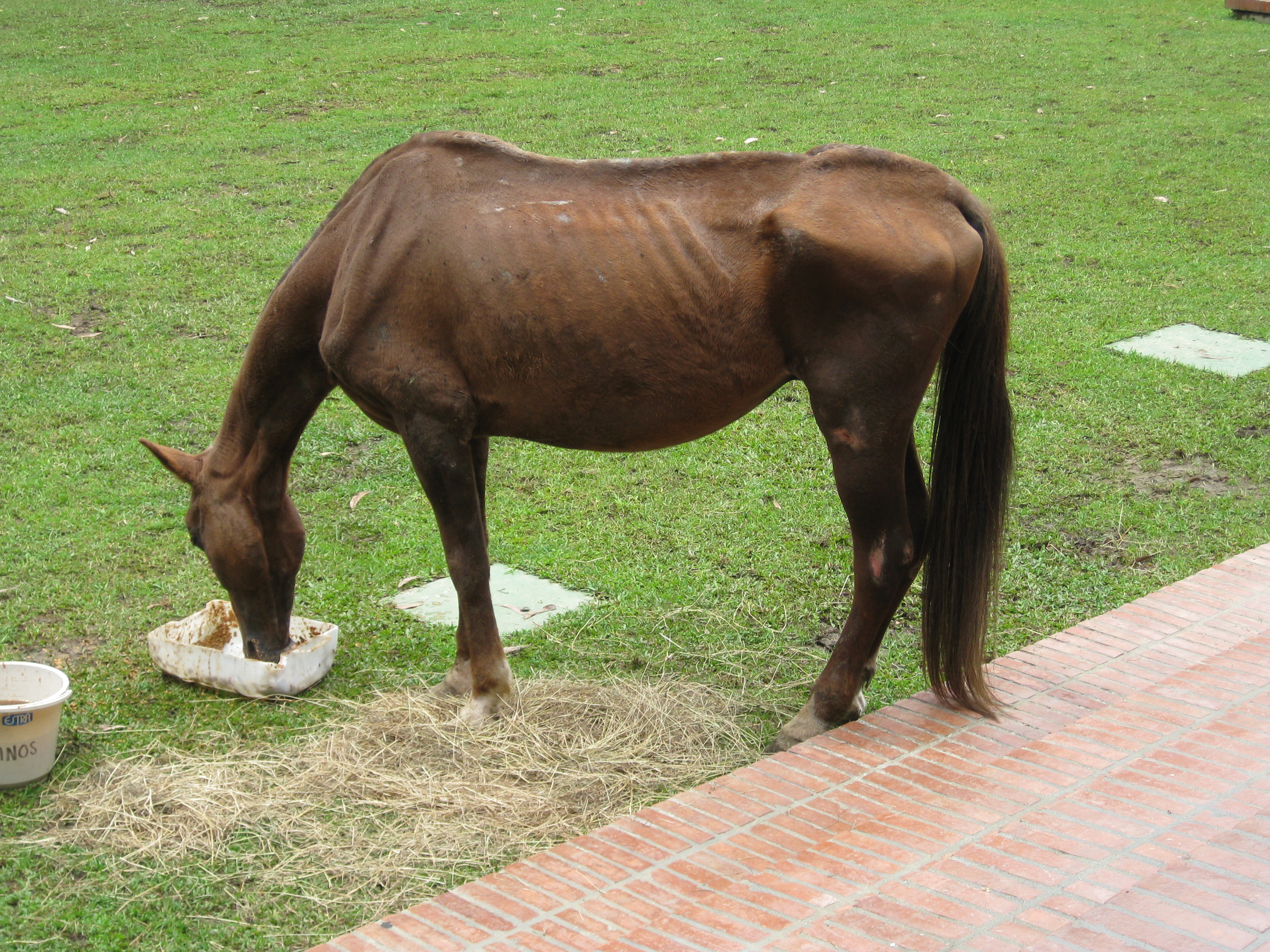|
Rodeos
Rodeo () is a competitive equestrian sport that arose out of the working practices of cattle herding in Spain and Mexico, expanding throughout the Americas and to other nations. It was originally based on the skills required of the working vaqueros and later, cowboys, in what today is the western United States, western Canada, and northern Mexico. Today, it is a sporting event that involves horses and other livestock, designed to test the skill and speed of the cowboys and cowgirls. American-style professional rodeos generally comprise the following events: tie-down roping, team roping, steer wrestling, saddle bronc riding, bareback bronc riding, bull riding and barrel racing. The events are divided into two basic categories: the rough stock events and the timed events. Depending on sanctioning organization and region, other events such as breakaway roping, goat tying, and pole bending may also be a part of some rodeos. The "world's first public cowboy contest" was held on July ... [...More Info...] [...Related Items...] OR: [Wikipedia] [Google] [Baidu] |
Calgary Stampede
The Calgary Stampede is an annual rodeo, exhibition, and festival held every July in Calgary, Alberta, Canada. The ten-day event, which bills itself as "The Greatest Outdoor Show on Earth", attracts over one million visitors per year and features one of the world's largest rodeos, a parade, midway, stage shows, concerts, agricultural competitions, chuckwagon racing, and First Nations exhibitions. In 2008, the Calgary Stampede was inducted into the ProRodeo Hall of Fame. The event's roots are traced to 1886 when the Calgary and District Agricultural Society held its first fair. In 1912, American promoter Guy Weadick organized his first rodeo and festival, known as the Stampede. He returned to Calgary in 1919 to organize the Victory Stampede in honour of soldiers returning from World War I. Weadick's festival became an annual event in 1923 when it merged with the Calgary Industrial Exhibition to create the Calgary Exhibition and Stampede. Organized by thousands of volunteers an ... [...More Info...] [...Related Items...] OR: [Wikipedia] [Google] [Baidu] |
Tie-down Roping
Calf roping, also known as tie-down roping, is a rodeo event that features a calf and a rider mounted on a horse. The goal of this timed event is for the rider to catch the calf by throwing a loop of rope from a lariat around its neck, dismount from the horse, run to the calf, and restrain it by tying three legs together, in as short a time as possible. A variant on the sport, with fewer animal welfare controversies, is breakaway roping, where the calf is roped, but not tied. Origin The event derives from the duties of actual working cowboys, which often required catching and restraining calves for branding or medical treatment. Ranch hands took pride in the speed with which they could rope and tie calves which soon turned their work into informal contests. Modern event The calves are lined up in a row and moved through narrow runways leading to a chute with spring-loaded doors. When a calf enters the chute, a door is closed behind it and a lightweight rope, attached t ... [...More Info...] [...Related Items...] OR: [Wikipedia] [Google] [Baidu] |
Roughstock
A bucking horse is any breed or either gender of horse with a propensity to buck. They have been, and still are, referred to by various names, including bronco, broncho, and roughstock. The harder they buck, the more desirable they are for rodeo events. Roughstock breeders have long established strings of bucking horses with broodmares and stallions that have been bred and crossbred to more consistently produce the desired temperaments and athletic ability needed for bareback and saddle bronc competition. Bareback broncs are typically smaller, faster athletes whereas saddle broncs are heavier bodied athletes of great strength and endurance. History Etymology The term comes from the Spanish language word ''bronco'' meaning "rough" (adj), or "gruff" (n), which in Mexican usage also describes the horse.; panish It was borrowed and adapted in U.S. cowboy lingo. It has also been spelled "broncho", though this form is virtually unknown in the western United States, wh ... [...More Info...] [...Related Items...] OR: [Wikipedia] [Google] [Baidu] |
Bull Riding
Bull riding is a rodeo sport that involves a rider getting on a bucking bull and attempting to stay mounted while the animal tries to buck off the rider. American bull riding has been called "the most dangerous eight seconds in sports." To receive a score, the rider must stay on top of the bull for eight seconds with the use of one hand gripped on a bull rope tied behind the bull's forelegs. Touching the bull or themselves with the free hand, or failing to reach the eight-second mark, results in a no-score ride. Depending on the bull riding organization and the contest, up to four judges might judge the rider and four judge the bull on their performance. For most organizations, a perfect score is 100 points. In general, most professional riders score in the neighborhood of the mid-70s to the high 80s. Outside of the United States, bull riding traditions with varying rules and histories also exist in Canada, Mexico, Belize, Guatemala, El Salvador, Honduras, Nicaragua, Costa Rica, ... [...More Info...] [...Related Items...] OR: [Wikipedia] [Google] [Baidu] |
Bareback Bronc Riding
Bronc riding, either bareback bronc or saddle bronc competition, is a rodeo event that involves a rodeo participant riding a bucking horse (sometimes called a ''bronc'' or ''bronco'') that attempts to throw or buck off the rider. Originally based on the necessary buck breaking skills of a working cowboy, the event is now a highly stylized competition that utilizes horses that often are specially bred for strength, agility, and bucking ability. It is recognized by the main rodeo organizations such as the Professional Rodeo Cowboys Association (PRCA) and the International Professional Rodeo Association (IPRA). Description Each competitor climbs onto a horse, which is held in a small pipe or wooden enclosure called a bucking chute. When the rider is ready, the gate of the bucking chute is opened and the horse bursts out and begins to buck. The rider attempts to stay on the horse for eight seconds without touching the horse with their free hand. On the first jump out of the chu ... [...More Info...] [...Related Items...] OR: [Wikipedia] [Google] [Baidu] |
Saddle Bronc Riding
Bronc riding, either bareback bronc or saddle bronc competition, is a rodeo event that involves a rodeo participant riding a bucking horse (sometimes called a ''bronc'' or ''bronco'') that attempts to throw or buck off the rider. Originally based on the necessary buck breaking skills of a working cowboy, the event is now a highly stylized competition that utilizes horses that often are specially bred for strength, agility, and bucking ability. It is recognized by the main rodeo organizations such as the Professional Rodeo Cowboys Association (PRCA) and the International Professional Rodeo Association (IPRA). Description Each competitor climbs onto a horse, which is held in a small pipe or wooden enclosure called a bucking chute. When the rider is ready, the gate of the bucking chute is opened and the horse bursts out and begins to buck. The rider attempts to stay on the horse for eight seconds without touching the horse with their free hand. On the first jump out of the chu ... [...More Info...] [...Related Items...] OR: [Wikipedia] [Google] [Baidu] |
Steer Wrestling
Steer wrestling, also known as bulldogging, is a rodeo event in which a horse-mounted rider chases a steer, drops from the horse to the steer, then wrestles the steer to the ground by grabbing its horns and pulling it off-balance so that it falls to the ground. The event carries a high risk of injury to the cowboy. Some concerns from the animal-rights community express that the competition may include practices that constitute cruelty to animals, but the injury rate to animals is less than 0.05%. A later PRCA survey of 60,971 animal performances at 198 rodeo performances and 73 sections of "slack" indicated 27 animals were injured, again around 0.05%. Origins Historically, steer wrestling was not a part of ranch life. The event originated in the 1890s, and is claimed to have been started by an individual named Bill Pickett, a wild-west show performer said to have caught a runaway steer by wrestling it to the ground. The several versions of the story have some claiming that he de ... [...More Info...] [...Related Items...] OR: [Wikipedia] [Google] [Baidu] |
National Finals Rodeo
The National Finals Rodeo (NFR) is the premier rodeo event by the Professional Rodeo Cowboys Association (PRCA). The NFR showcases the talents of the PRCA's top 15 money-winners in the season for each event. The NFR is held each year in the first full week of December, at the Thomas & Mack Center on the campus of the University of Nevada, Las Vegas in Paradise, Nevada, United States. (UNLV) and is aired live on The Cowboy Channel. ''Cowboy Christmas'', a cowboy gift show, is held concurrent with the rodeo at the Las Vegas Convention Center. Since the rodeo uses 'special dirt', the dirt is stored on the UNLV campus for use in the next NFR. Events The NFR is the final rodeo event of the PRCA season. World championship titles are awarded to the individuals who earn the most money in his or her event throughout the year. 7 events and 9 championships are sanctioned by the PRCA: * Bareback Riding - a rider has to stay on a bucking horse and is only allowed to hang on with a "rig ... [...More Info...] [...Related Items...] OR: [Wikipedia] [Google] [Baidu] |
Cowgirls
A cowboy is an animal herder who tends cattle on ranches in North America, traditionally on horseback, and often performs a multitude of other ranch-related tasks. The historic American cowboy of the late 19th century arose from the ''vaquero'' traditions of northern Mexico and became a figure of special significance and legend.Malone, J., p. 1. A subtype, called a wrangler, specifically tends the horses used to work cattle. In addition to ranch work, some cowboys work for or participate in rodeos. Cowgirls, first defined as such in the late 19th century, had a less-well documented historical role, but in the modern world work at identical tasks and have obtained considerable respect for their achievements. Cattle handlers in many other parts of the world, particularly South America and Australia, perform work similar to the cowboy. The cowboy has deep historic roots tracing back to Spain and the earliest European settlers of the Americas. Over the centuries, differences in te ... [...More Info...] [...Related Items...] OR: [Wikipedia] [Google] [Baidu] |
Cowboy
A cowboy is an animal herder who tends cattle on ranches in North America, traditionally on horseback, and often performs a multitude of other ranch-related tasks. The historic American cowboy of the late 19th century arose from the '' vaquero'' traditions of northern Mexico and became a figure of special significance and legend.Malone, J., p. 1. A subtype, called a wrangler, specifically tends the horses used to work cattle. In addition to ranch work, some cowboys work for or participate in rodeos. Cowgirls, first defined as such in the late 19th century, had a less-well documented historical role, but in the modern world work at identical tasks and have obtained considerable respect for their achievements. Cattle handlers in many other parts of the world, particularly South America and Australia, perform work similar to the cowboy. The cowboy has deep historic roots tracing back to Spain and the earliest European settlers of the Americas. Over the centuries, differences ... [...More Info...] [...Related Items...] OR: [Wikipedia] [Google] [Baidu] |
Women's Professional Rodeo Association
The Women's Professional Rodeo Association (WPRA) is one of the largest rodeo sanctioning bodies in the world and is open exclusively to women eighteen years of age and older. Headquartered in Colorado Springs, Colorado, the Association currently has over 3,000 members from all over the contiguous United States, Canada, and Australia. In 2004, WPRA members competed for nearly $5 million in total prize money at rodeos in the United States and co-sanctioned Canadian Professional Rodeo Association (CPRA) events in Canada. History Formed as the Girls Rodeo Association (GRA) in 1948, several of the original members were female ranchers who had been forced to take over family operations as husbands, fathers, and brothers were called to service in World War II. Though women had played an important role in rodeo's formative years in the mid-to-late nineteenth century, competing and winning against their male counterparts, by the time of the GRA's formation women's role in rodeo had ... [...More Info...] [...Related Items...] OR: [Wikipedia] [Google] [Baidu] |
Animal Cruelty
Cruelty to animals, also called animal abuse, animal neglect or animal cruelty, is the infliction by omission (neglect) or by commission by humans of suffering or Injury, harm upon non-human animals. More narrowly, it can be the causing of harm or suffering for specific achievements, such as killing animals for entertainment; cruelty to animals sometimes encompasses inflicting harm or suffering as an end in itself, referred to as zoosadism. Divergent approaches to Animal rights by country or territory, laws concerning animal cruelty occur in different jurisdictions throughout the world. For example, some laws govern methods of killing animals for food, clothing, or other products, and other laws concern the keeping of animals for entertainment, education, research, or pets. There are several conceptual approaches to the issue of cruelty to animals. Even though some practices, like animal fighting, are widely acknowledged as cruel, not all people and nations have the same defini ... [...More Info...] [...Related Items...] OR: [Wikipedia] [Google] [Baidu] |
.jpg)



.jpg)


